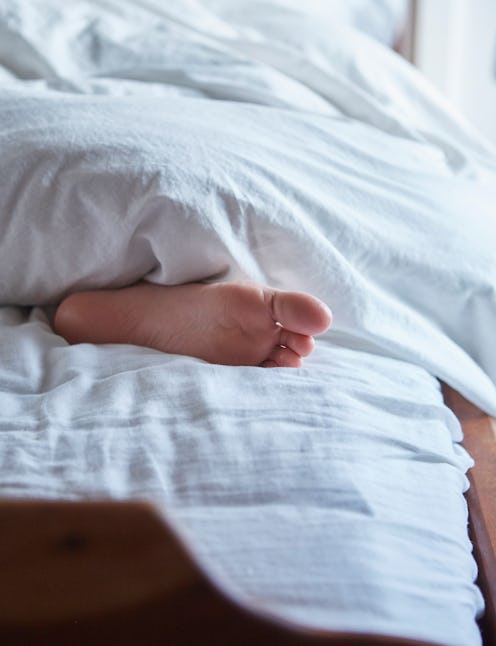Life
Why You Sleep With One Foot Outside The Covers

Have you ever experienced one of those middle-of-the-night dilemmas where you can't decide if you want to be under or over the covers? I certainly have. I cannot sleep without being covered — but I also live in the desert, where the 115-degree heat is just a tad overwhelming. I always end up with one leg out from under the covers. It turns out that science has explained why people sleep with one foot outside the covers, and it has to do with how we're trying to regulate our own body temperature.
A recent video posted on the Facebook page Unbelievable Facts delves into the science of exactly why some of us leave one foot uncovered when we're experiencing that hot-but-cold-at-the-same-time feeling. Aside from being hairless (and thus likely more sensitive to temperature changes), our feet also hold special vascular structures that make them an exit point for your body heat. When we want to noticeably lower our body temperature without having to be uncovered, exposing even one foot can make all the difference.
Similarly, if you're cold, putting on a pair of socks could warm you up significantly. That's probably why I love wearing socks to bed in the winter, when my feet are normally icicles. Check out Unbelievable Facts' full video below:
This isn't the first time this concept has been examined. A University of Alabama professor and spokesperson for the National Sleep Foundation, Natalie Dautovich, spoke with New York Magazine in 2014 about why sticking one foot out of the covers is so helpful. Since they are extremities, their arteriovenous anastomoses link arteries to veins. When it's warm, they dilate and let more blood reach the skin in order to cool us down.
All of this points to one more over-arching fact: We sleep better when we're a little colder. Naturally on its own, your body temperature decreases to promote sleep — and giving your internal thermostat a little push could encourage an even more restful night. In fact, one study out of the University of Pittsburgh School of Medicine found that people suffering from insomnia who wore a cooling cap slept almost as well as people without insomnia. The Center for Chronobiology in Switzerland additionally found that when your core body temperature is lowered, all of the sleepy-time systems in your body kick into gear.
Another interesting piece of information supporting this is the way our body temperature changes throughout the span of an entire day. It's at its highest in the early afternoon, which makes sense when you think about it: If your body is coolest when it's time to sleep, it fits that it's warmest when many of us are at our most alert.
Other research notes that we hit our coolest temperature around 5:00 a.m. specifically. (Side note: This is when I wake up, and believe you me, my body does not like it. Now I understand why a little better — my body is still in sleep mode!)
All of this helps explain the findings of one study, which showed that participants slept a whole hour longer in winter (when the days are shorter and colder).
While this whole concept is widely known, many of us still crank up the heat because we like to be nice and toasty under the covers. But studies have found that temperature could play an even bigger role in sleep quality than light does — something else that has been heavily researched and studied.
The specifics vary slightly, but some research says that our body temperature needs to decrease by about two or three degrees to help facilitate sleep. Out of all the research I've done, the general consensus seems to be that setting your thermostat anywhere from 60 to 67 degrees is ideal for a solid night of sleep.
If you want to learn a little more about how body temperature affects sleep (and likewise, alertness), you can also check out this video from NY Mag:
Images: Getty Images (2)